This is the error I get when I attempt to register an account on my local ASP.NET MVC project. This all started when I tried to move the default account manager over to my main DbContext. It worked fine while it was still on "DefaultConnection."
Exception Details: System.Data.SqlClient.SqlException: Invalid column name 'UserName'.
Invalid column name 'UserName'.
Invalid column name 'Email'.
Invalid column name 'EmailConfirmed'.
Invalid column name 'PasswordHash'.
Invalid column name 'SecurityStamp'.
Invalid column name 'PhoneNumber'.
Invalid column name 'PhoneNumberConfirmed'.
Invalid column name 'TwoFactorEnabled'.
Invalid column name 'LockoutEndDateUtc'.
Invalid column name 'LockoutEnabled'.
Invalid column name 'AccessFailedCount'.
Invalid column name 'UserName'.
Source of the error is this statement from the default AccountController:
var result = await UserManager.CreateAsync(user, model.Password);
This is what my tables look like. I've been fiddling for a long time; IdentityUser was not always there, and now it seems it has "taken" AspNetUsers's column names... very odd.
This is my DbContext file
public class MainContext : IdentityDbContext<ApplicationUser>
{
public MainContext() : base("MainContext")
{
Database.SetInitializer(new DropCreateDatabaseAlways<MainContext>());
}
public DbSet<Story> Stories { get; set; }
protected override void OnModelCreating(DbModelBuilder modelBuilder)
{
modelBuilder.Conventions.Remove<PluralizingTableNameConvention>();
base.OnModelCreating( modelBuilder );
modelBuilder.Entity<IdentityUser>().HasKey( t => t.Id );
modelBuilder.Entity<IdentityUserLogin>().HasKey( l => new {l.UserId, l.ProviderKey, l.LoginProvider} );
modelBuilder.Entity<IdentityRole>().HasKey( r => r.Id );
modelBuilder.Entity<IdentityUserRole>().HasKey( r => new { r.RoleId, r.UserId } );
}
public DbSet<ViewModels.StoryDetailsVm> StoryViewModels { get; set; }
public DbSet<ViewModels.StoryEditVm> StoryEditVMs { get; set; }
}
This is my IdentityModels file
public class ApplicationUser : IdentityUser
{
public async Task<ClaimsIdentity> GenerateUserIdentityAsync(UserManager<ApplicationUser> manager)
{
// Note the authenticationType must match the one defined in CookieAuthenticationOptions.AuthenticationType
var userIdentity = await manager.CreateIdentityAsync(this, DefaultAuthenticationTypes.ApplicationCookie);
// Add custom user claims here
return userIdentity;
}
}
public class ApplicationDbContext : IdentityDbContext<ApplicationUser>
{
public ApplicationDbContext()
: base("MainContext", throwIfV1Schema: false)
{
}
public static ApplicationDbContext Create()
{
return new ApplicationDbContext();
}
}
I've been trying to solve this for 6 hours. Would greatly appreciate any help I can get. Apologies for all this code, I have no idea where the problem lies.
Stack trace
[SqlException (0x80131904): Invalid column name 'UserName'.
Invalid column name 'UserName'.
Invalid column name 'Email'.
Invalid column name 'EmailConfirmed'.
Invalid column name 'PasswordHash'.
Invalid column name 'SecurityStamp'.
Invalid column name 'PhoneNumber'.
Invalid column name 'PhoneNumberConfirmed'.
Invalid column name 'TwoFactorEnabled'.
Invalid column name 'LockoutEndDateUtc'.
Invalid column name 'LockoutEnabled'.
Invalid column name 'AccessFailedCount'.
Invalid column name 'UserName'.]
System.Data.SqlClient.<>c.<ExecuteDbDataReaderAsync>b__167_0(Task`1 result) +870314
System.Threading.Tasks.ContinuationResultTaskFromResultTask`2.InnerInvoke() +77
System.Threading.Tasks.Task.Execute() +49
System.Runtime.CompilerServices.TaskAwaiter.ThrowForNonSuccess(Task task) +92
System.Runtime.CompilerServices.TaskAwaiter.HandleNonSuccessAndDebuggerNotification(Task task) +58
System.Data.Entity.Core.EntityClient.Internal.<ExecuteStoreCommandsAsync>d__c.MoveNext() +249
[EntityCommandExecutionException: An error occurred while executing the command definition. See the inner exception for details.]
System.Data.Entity.Core.EntityClient.Internal.<ExecuteStoreCommandsAsync>d__c.MoveNext() +334
System.Runtime.CompilerServices.TaskAwaiter.ThrowForNonSuccess(Task task) +92
System.Runtime.CompilerServices.TaskAwaiter.HandleNonSuccessAndDebuggerNotification(Task task) +58
System.Data.Entity.Core.Objects.Internal.<ExecuteAsync>d__0`1.MoveNext() +1515
System.Runtime.CompilerServices.TaskAwaiter.ThrowForNonSuccess(Task task) +92
System.Runtime.CompilerServices.TaskAwaiter.HandleNonSuccessAndDebuggerNotification(Task task) +58
System.Data.Entity.Utilities.CultureAwaiter`1.GetResult() +59
System.Data.Entity.Core.Objects.<ExecuteInTransactionAsync>d__3d`1.MoveNext() +862
System.Runtime.CompilerServices.TaskAwaiter.ThrowForNonSuccess(Task task) +92
System.Runtime.CompilerServices.TaskAwaiter.HandleNonSuccessAndDebuggerNotification(Task task) +58
System.Data.Entity.SqlServer.<ExecuteAsyncImplementation>d__9`1.MoveNext() +358
System.Runtime.CompilerServices.TaskAwaiter.ThrowForNonSuccess(Task task) +92
System.Runtime.CompilerServices.TaskAwaiter.HandleNonSuccessAndDebuggerNotification(Task task) +58
System.Data.Entity.Utilities.CultureAwaiter`1.GetResult() +59
System.Data.Entity.Core.Objects.<GetResultsAsync>d__e.MoveNext() +632
System.Runtime.CompilerServices.TaskAwaiter.ThrowForNonSuccess(Task task) +92
System.Runtime.CompilerServices.TaskAwaiter.HandleNonSuccessAndDebuggerNotification(Task task) +58
System.Data.Entity.Utilities.CultureAwaiter`1.GetResult() +59
System.Data.Entity.Internal.<FirstMoveNextAsync>d__0.MoveNext() +261
System.Runtime.CompilerServices.TaskAwaiter.ThrowForNonSuccess(Task task) +92
System.Runtime.CompilerServices.TaskAwaiter.HandleNonSuccessAndDebuggerNotification(Task task) +58
System.Data.Entity.Infrastructure.<FirstOrDefaultAsync>d__25`1.MoveNext() +349
System.Runtime.CompilerServices.TaskAwaiter.ThrowForNonSuccess(Task task) +92
System.Runtime.CompilerServices.TaskAwaiter.HandleNonSuccessAndDebuggerNotification(Task task) +58
System.Runtime.CompilerServices.TaskAwaiter`1.GetResult() +28
Microsoft.AspNet.Identity.CultureAwaiter`1.GetResult() +75
Microsoft.AspNet.Identity.EntityFramework.<GetUserAggregateAsync>d__6c.MoveNext() +682
System.Runtime.CompilerServices.TaskAwaiter.ThrowForNonSuccess(Task task) +92
System.Runtime.CompilerServices.TaskAwaiter.HandleNonSuccessAndDebuggerNotification(Task task) +58
System.Runtime.CompilerServices.TaskAwaiter`1.GetResult() +28
Microsoft.AspNet.Identity.CultureAwaiter`1.GetResult() +75
Microsoft.AspNet.Identity.<ValidateUserName>d__4.MoveNext() +607
System.Runtime.CompilerServices.TaskAwaiter.ThrowForNonSuccess(Task task) +92
System.Runtime.CompilerServices.TaskAwaiter.HandleNonSuccessAndDebuggerNotification(Task task) +58
System.Runtime.CompilerServices.TaskAwaiter.GetResult() +26
Microsoft.AspNet.Identity.CultureAwaiter.GetResult() +44
Microsoft.AspNet.Identity.<ValidateAsync>d__0.MoveNext() +235
System.Runtime.CompilerServices.TaskAwaiter.ThrowForNonSuccess(Task task) +92
System.Runtime.CompilerServices.TaskAwaiter.HandleNonSuccessAndDebuggerNotification(Task task) +58
System.Runtime.CompilerServices.TaskAwaiter`1.GetResult() +28
Microsoft.AspNet.Identity.CultureAwaiter`1.GetResult() +75
Microsoft.AspNet.Identity.<CreateAsync>d__0.MoveNext() +422
System.Runtime.CompilerServices.TaskAwaiter.ThrowForNonSuccess(Task task) +92
System.Runtime.CompilerServices.TaskAwaiter.HandleNonSuccessAndDebuggerNotification(Task task) +58
System.Runtime.CompilerServices.TaskAwaiter`1.GetResult() +28
Microsoft.AspNet.Identity.CultureAwaiter`1.GetResult() +75
Microsoft.AspNet.Identity.<CreateAsync>d__d.MoveNext() +475
System.Runtime.CompilerServices.TaskAwaiter.ThrowForNonSuccess(Task task) +92
System.Runtime.CompilerServices.TaskAwaiter.HandleNonSuccessAndDebuggerNotification(Task task) +58
System.Runtime.CompilerServices.TaskAwaiter`1.GetResult() +28
fcon.Controllers.<Register>d__15.MoveNext() in C:\Users\G\Documents\Visual Studio 2015\Projects\fcon\fcon\Controllers\AccountController.cs:157
System.Runtime.CompilerServices.TaskAwaiter.ThrowForNonSuccess(Task task) +92
System.Runtime.CompilerServices.TaskAwaiter.HandleNonSuccessAndDebuggerNotification(Task task) +58
System.Runtime.CompilerServices.TaskAwaiter.GetResult() +26
System.Threading.Tasks.TaskHelpersExtensions.ThrowIfFaulted(Task task) +42
System.Web.Mvc.Async.TaskAsyncActionDescriptor.EndExecute(IAsyncResult asyncResult) +73
System.Web.Mvc.Async.<>c__DisplayClass37.<BeginInvokeAsynchronousActionMethod>b__36(IAsyncResult asyncResult) +37
System.Web.Mvc.Async.WrappedAsyncResult`1.CallEndDelegate(IAsyncResult asyncResult) +27
System.Web.Mvc.Async.WrappedAsyncResultBase`1.End() +58
System.Web.Mvc.Async.AsyncResultWrapper.End(IAsyncResult asyncResult, Object tag) +68
System.Web.Mvc.Async.AsyncControllerActionInvoker.EndInvokeActionMethod(IAsyncResult asyncResult) +34
System.Web.Mvc.Async.AsyncInvocationWithFilters.<InvokeActionMethodFilterAsynchronouslyRecursive>b__3d() +69
System.Web.Mvc.Async.<>c__DisplayClass46.<InvokeActionMethodFilterAsynchronouslyRecursive>b__3f() +230
System.Web.Mvc.Async.<>c__DisplayClass33.<BeginInvokeActionMethodWithFilters>b__32(IAsyncResult asyncResult) +27
System.Web.Mvc.Async.WrappedAsyncResult`1.CallEndDelegate(IAsyncResult asyncResult) +27
System.Web.Mvc.Async.WrappedAsyncResultBase`1.End() +58
System.Web.Mvc.Async.AsyncResultWrapper.End(IAsyncResult asyncResult, Object tag) +68
System.Web.Mvc.Async.AsyncControllerActionInvoker.EndInvokeActionMethodWithFilters(IAsyncResult asyncResult) +34
System.Web.Mvc.Async.<>c__DisplayClass2b.<BeginInvokeAction>b__1c() +42
System.Web.Mvc.Async.<>c__DisplayClass21.<BeginInvokeAction>b__1e(IAsyncResult asyncResult) +124
System.Web.Mvc.Async.WrappedAsyncResult`1.CallEndDelegate(IAsyncResult asyncResult) +27
System.Web.Mvc.Async.WrappedAsyncResultBase`1.End() +58
System.Web.Mvc.Async.AsyncResultWrapper.End(IAsyncResult asyncResult, Object tag) +30
System.Web.Mvc.Async.AsyncControllerActionInvoker.EndInvokeAction(IAsyncResult asyncResult) +29
System.Web.Mvc.Controller.<BeginExecuteCore>b__1d(IAsyncResult asyncResult, ExecuteCoreState innerState) +27
System.Web.Mvc.Async.WrappedAsyncVoid`1.CallEndDelegate(IAsyncResult asyncResult) +48
System.Web.Mvc.Async.WrappedAsyncResultBase`1.End() +58
System.Web.Mvc.Async.AsyncResultWrapper.End(IAsyncResult asyncResult, Object tag) +30
System.Web.Mvc.Async.AsyncResultWrapper.End(IAsyncResult asyncResult, Object tag) +21
System.Web.Mvc.Controller.EndExecuteCore(IAsyncResult asyncResult) +32
System.Web.Mvc.Controller.<BeginExecute>b__15(IAsyncResult asyncResult, Controller controller) +26
System.Web.Mvc.Async.WrappedAsyncVoid`1.CallEndDelegate(IAsyncResult asyncResult) +40
System.Web.Mvc.Async.WrappedAsyncResultBase`1.End() +58
System.Web.Mvc.Async.AsyncResultWrapper.End(IAsyncResult asyncResult, Object tag) +30
System.Web.Mvc.Async.AsyncResultWrapper.End(IAsyncResult asyncResult, Object tag) +21
System.Web.Mvc.Controller.EndExecute(IAsyncResult asyncResult) +29
System.Web.Mvc.Controller.System.Web.Mvc.Async.IAsyncController.EndExecute(IAsyncResult asyncResult) +24
System.Web.Mvc.MvcHandler.<BeginProcessRequest>b__5(IAsyncResult asyncResult, ProcessRequestState innerState) +27
System.Web.Mvc.Async.WrappedAsyncVoid`1.CallEndDelegate(IAsyncResult asyncResult) +48
System.Web.Mvc.Async.WrappedAsyncResultBase`1.End() +58
System.Web.Mvc.Async.AsyncResultWrapper.End(IAsyncResult asyncResult, Object tag) +30
System.Web.Mvc.Async.AsyncResultWrapper.End(IAsyncResult asyncResult, Object tag) +21
System.Web.Mvc.MvcHandler.EndProcessRequest(IAsyncResult asyncResult) +29
System.Web.Mvc.MvcHandler.System.Web.IHttpAsyncHandler.EndProcessRequest(IAsyncResult result) +23
System.Web.CallHandlerExecutionStep.OnAsyncHandlerCompletion(IAsyncResult ar) +129
Keywords for Google: DropCreateDatabaseAlways Manually Delete Database Old Model
